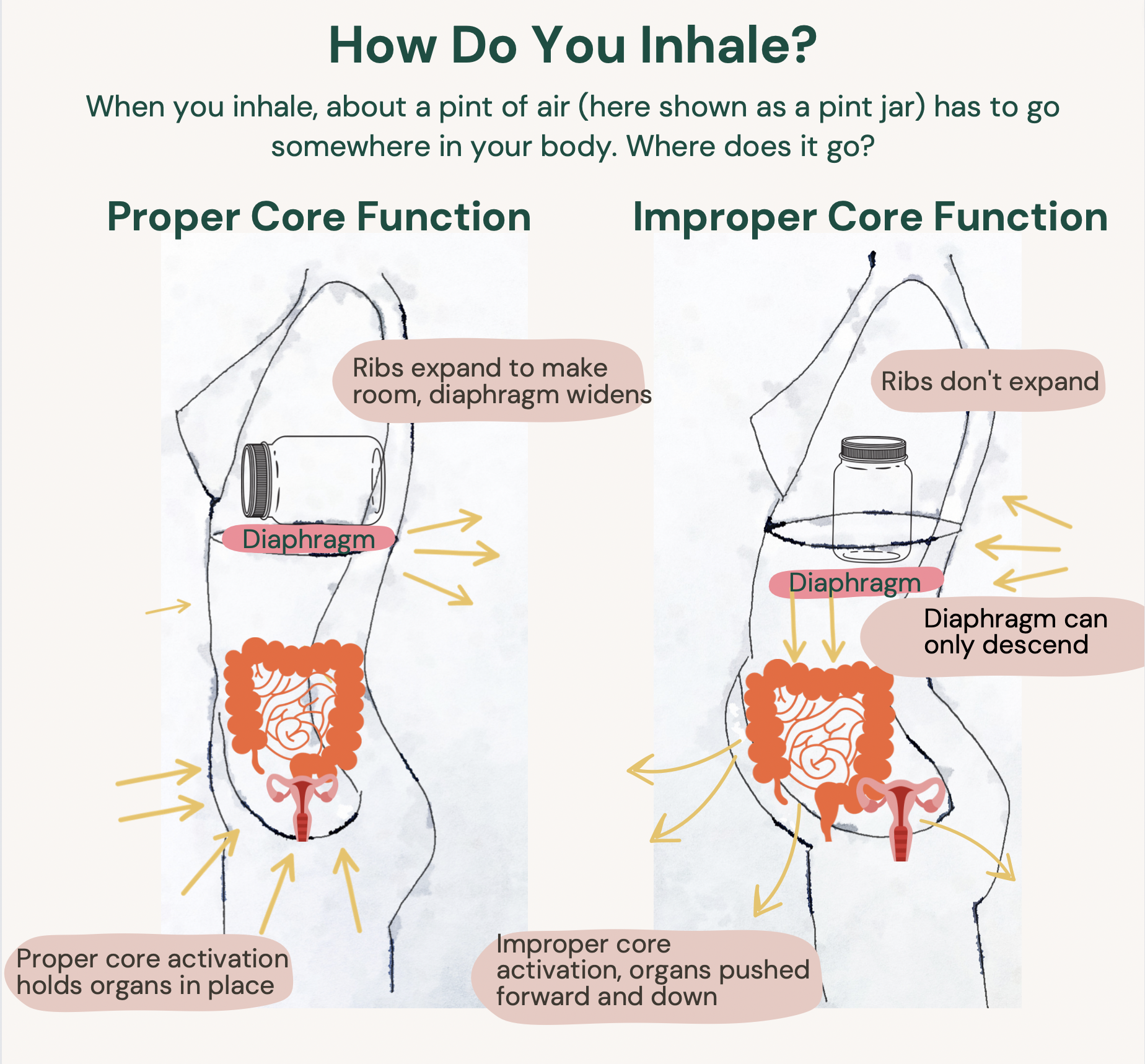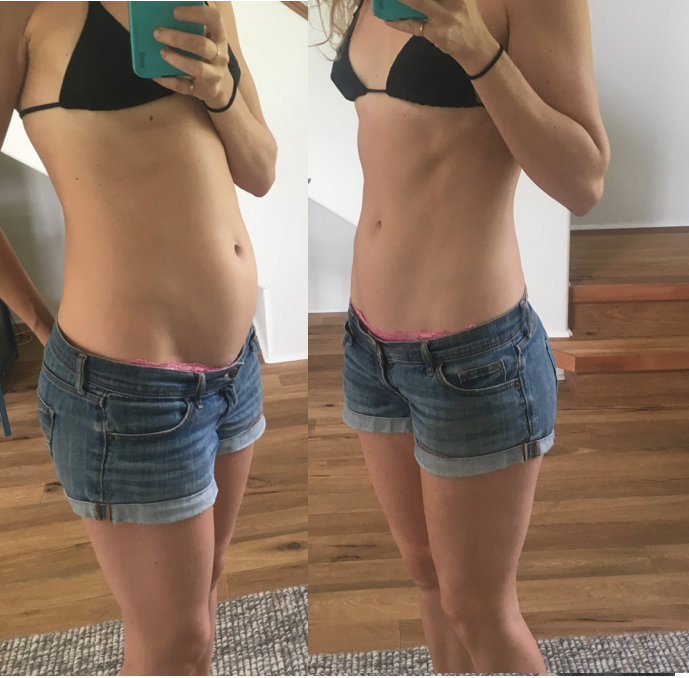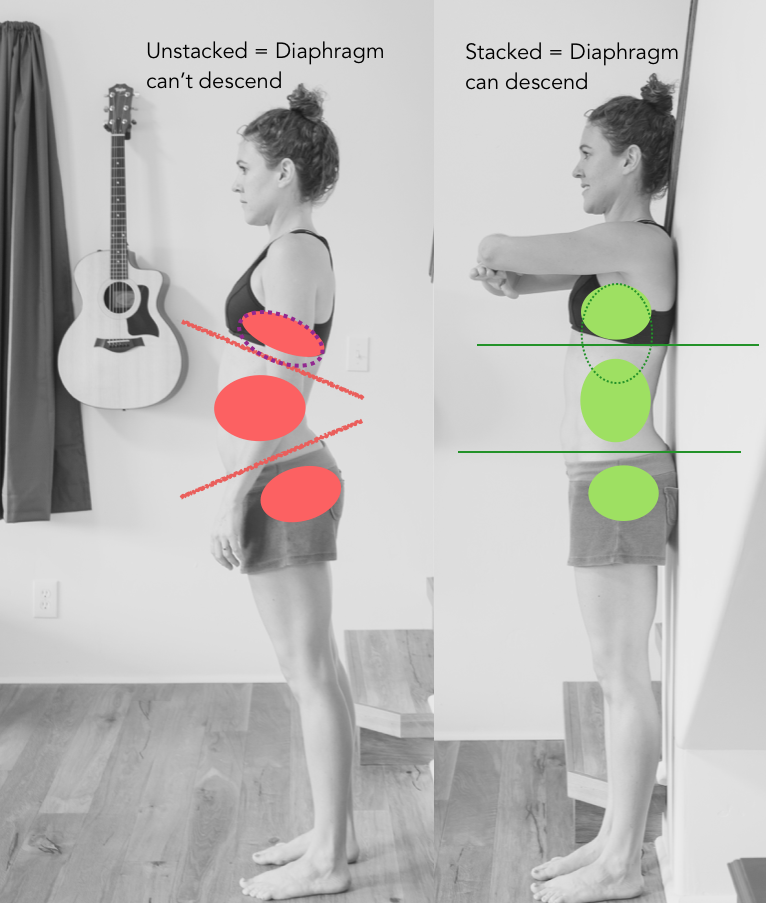Breathing Through Endometriosis: Literally, Breathing
Here’s an important question: Do you breathe correctly? Obviously, you’re still alive, so you’re definitely breathing, but you may be much more oxygen-starved than you know if you’re not breathing correctly.
Most of us never learned to use our breath in the right capacity, and we end up shallowly breathing from our upper chest all day long. All-life-long. This not only makes us oxygen-starved, and therefore chronically fatigued (ahem, endometriosis), but it also creates stagnation in the abdominal and pelvic cavities by not allowing these areas movement. Moreover, poor breathing patterns allow the deep core muscles to become atrophied. Core dysfunction ensues.
Core Dysfunction, Poor Breathing, and a Uterus Punching Bag
But being too sedentary combined with shallow breathing leads to atrophied core muscles, which become stiff, inflexible, and weak—altogether unable to function correctly. Core dysfunction ensues. When this happens, your core musculature is no longer working together properly. When dysfunctional, the deep core becomes confused about when it should brace—such as when you cough, sneeze, or pick up items off the floor (leading to back pain, pelvic pain, prolapse, and more)—or when it should relax—like when you’re breathing (leading to shallow breathing and anxiety), having sex (leading to pain), or when you are pooping (leading to constipation). In all, core dysfunction can lead to pelvic pain, pelvic floor dysfunction, digestive problems, sexual dysfunction, disk herniation, prolapse, and more.
When core muscles become confused and weak like this, it can also lead to an issue called mismanaged intra-abdominal pressure (IAP), and vice versa. IAP refers to the natural, slight pressure that exists inside your abdomen. Think about it, there are no direct holes in or out of your abdomen (like when you’re really bloated, extra “stuff” doesn’t pop out of your belly button or vagina to make room). Rather, your abdomen is an airtight container that houses your vital organs, so when something happens to take up more room inside (like bloating or inhaling air), the pressure in your abdomen increases rather than organs falling out. When this pressure is correctly managed (with the proper expansion of your ribs and firing of your deep core muscles), this is not a problem. But when you add core dysfunction to the picture, that internal pressure can quickly become a big issue for endo.
If you have core dysfunction, your ribs might not budge while you are breathing. This means that as your lungs fill up with air, your diaphragm will be forced to descend deeper than it should into the abdomen, pushing your organs (including your reproductive organs) down with it. And, if your deep core is inactivated or confused, it won’t properly brace, allowing your organs to be pushed into the lower belly and down onto the pelvic floor. This is mismanaged IAP, something you can visually see if, when you breathe, sneeze, cough, yell, or sing, your lower belly pushes out with each breath (no, your lower tummy does not have air in it, those are your organs).
It is obviously problematic for our endo when the brunt of 11 pounds of organs are continuously being pushed down onto the uterus, ovaries, cysts, and endo lesions. It may be why you have a painful endo flare during exercise (or simply getting up quickly off the couch). It’s how an hour of yoga, cross-fit, Pilates, or HIIT combined with core dysfunction can cause damage at the cellular level, perhaps even bursting cysts or provoking your endo misery. It may be why you have a bloated-looking lower tummy that won’t “flatten” no matter how many crunches you do. Not to mention that constant battery like this may be contributing to an inflammatory pelvic environment without you realizing it. That’s why retraining core function and decreasing the pressure on your organs is a foundational need of the endo body.
1) RELEASE YOUR TUMMY
The first thing I’m going to have to you is … RELEASE your stomach. Dun dun dunnnnnnn. Yes, I mean it, all of it. If you’re like pretty much everyone in America, you’re stomach is clenched tight right now, either sucking in or flexing or whatever it is you do to make your tummy look flat. Since endo-sisters are phenomenal at sucking in, this may be no easy feat. When we have endo-bloat to cover all the time, our gut-suck-in-reflex get’s Viking Strong!
BUT, in order to breathe correctly your diaphragm needs to out, then go down, so let it through your viking shield wall by r-e-l-e-a-s-i-n-g your grip. When your tummy is tensed up or sucked in, your diaphragm is literally stuck. Here’s me as an example: These pictures were taken 20 seconds apart, not after a cleanse. On the left I’m releasing my stomach, THIS ISN’T ENDO BELLY. This is a normal human body that’s relaxed (yes, everyone has a little pot belly, it's natural). On the right I’m tensing my stomach so all my “embarrassing” internal organs are hidden. Where are they hidden, you might ask? Up in my thoracic cavity, sticking my diaphragm to my lungs, that’s where.
This is not endo belly on the lest, this is a healthy, natural, relaxed belly after eating. The problematic belly is on the right: tense and stiff.
When your belly is relaxed, your diaphragm has room to descend. When it's tense and stiff, there can't be any movement, even you want it to.
Letting your belly out might be frightening. If you’re screaming angrily at the computer right now “You expect me to go out in public like that??!” I would never ask that :) I mean, in an ideal world I’d love everyone to release their tummies all the time and be happy and dance a lot on the streets (like when I lived in Senegal), but Americans aren’t ready for that .. yet. Instead, I suggest you find times to let your belly hang out where you feel most comfortable. I began with the shower, the car, and when sitting at my computer.
Just as important, find times you can do this while you’re doing physical activities, like walking. Retraining your body to relax and breathe as you move will have a thousand times benefit on your body because it will allow that deep, intrinsic core strength I talk about all the time to really shine. If you’ve been using a tense outer-sheath of muscle to hold yourself up (along with ligaments and a sore spine), you’ll be able to feel how releasing the outer muscles allow those inner muscles to wake up and your deep core to activate. (Shallow note: You know what that does? Gives you a naturally flatter stomach without sucking in all the time)
As you do this make sure you only walk as far as you can without over-tiring these muscles, since they’re most likely not used to holding your upper body upright. If you are still finding it hard to release your stomach all the way, I recommend laying down on your bed our couch. Here all your muscles can relax without gravity, and you can now focus on your diaphragm expanding.
2) RELEASE YOUR RIBS
THIS IS SO IMPORTANT! Now that your stomach is released it’s time to wake up your rib cage. This bone and muscle sheath opens up to make room for your expanding diaphragm, which is very important for a very important reason which is important especially if you have pelvic floor issues or endometriosis. So important to you :)
Your 3 cavities have just enough space for all the bits inside. Add a big chunk of air and it’s like stuffing another big organ in there, if nothing moves there’s not enough room! When there’s not enough room there will be excess pressure put on to your organs, and with gravity that pressure will go downnnnn, down your your pelvic floor. That could cause a number of issues, including a pelvic organ prolapse (weakness combine with this “pressure” to push your bladder or uterus out your vagina).
That’s why your ribs move! They do, they do. When you take that big breath your ribs open from side to side and expand across the back, which is a really beautiful thing to feel for the first time if you’re a breathing newby (I would get chills when I first started being able to feel this).
To get the hang of this you can try pushing your hands against your lower ribs (push harder, more, there you go) and then trying to “push” your hands away with your ribs on each breath. Fill your lungs completely while you do this so you expand allll the way into your back as well. These muscles are probably gray matter as well, so be kind to them if they’re weak or inactive. With a little time and use they’ll rehab right back to normal.
Fill your lungs and feel your hands being pushed away as your strong ribs make room for that air
3) STACK YOUR CAVITIES
If you’re thrusting your ribs or throwing your hips in front of your body, you’re de-stacking your cavities. That makes it very difficult for your diaphragm to descend. Since I’m obviously a visual person, here’s a colorful picture to demonstrate how an un-stacked body inhibits your cavities from working together as a team. This is another reason laying down on a bed or couch is a great place to get started, so you don't have to think about all these corrections while you focus on what's most important: breathing.
4) RELEASE YOUR ARMS OVER YOUR HEAD
Now that you know how to release your belly and recruit your ribs and stack yo’self, you’re well on the way to breathing! But here’s one more tip to help during the transition if you’re still finding it tough: lift your arms over your head. This will give your ribs room to move without these tight muscles holding you back. You can do this laying down, or simply lift your arms and drape them over your head while you take some big, beautiful breaths.
PRACTICE PRACTICE PRACTICE
Breathing well like this can be frustratingly challenging to the chronically ill since we sometimes lack the simple muscles needed, not to mention we’re tight all over, not to mention most of us have been chest breathing since the dawn of our lives. Well, I had been anyways :/ That’s why this process might take a while, because not only do you have to retrain your diaphragm to actually work, but you have to also retrain yourself to not tense your stomach all day long, not to thrust your ribs, and strengthen the intercostals. That’s why practicing while laying down will help, as will in privacy where you can really tune into your body and where the iron grip can be released.
But you know what, if I "Iron Lung" can do it anyone can learn how to do it! Be patient, practice often, release that beautiful belly of yours, and let the air flow.





